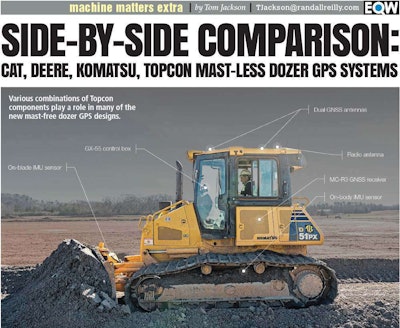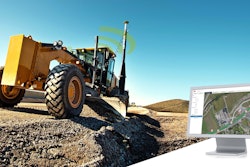
In the past 18 months, however, several major manufacturers have begun integrating these systems into the physical structure of their machines, creating integrated systems that not only improve the grade control performance, but make the process less cumbersome from a hardware perspective.
On previous generations of systems, one or two GPS receivers were bolted somewhat awkwardly on long mast poles attached to the blade. Long cables – draped from the receivers to the body of the dozer – carried blade positioning information to the controllers in the cab.
The new “mast-less” systems use low profile receivers on the top of the cab and various combinations of sensors and inertial measurement units (IMUs) to orient the X-Y-Z position of the blade in space. The IMUs are basically gyroscopes mated to a controller or mini-computer.
One immediate benefit all these systems offer is that you no longer must attach to and remove the receivers or masts every day. The cost of these receivers made them attractive to thieves. Climbing up on the blade to remove the masts is also a safety concern. Not to mention they were somewhat precarious, since the masts were at risk of snapping off if the dozer was jolted hard enough. Finally, there was the possibility of the cables fraying or getting snagged in trees or other jobsite protrusions. All those concerns vanished with the new mast-free systems.
Aside from the physical advantages of the new systems, the mast-less systems dial into sophisticated software in the controllers that help you optimize the cut on each pass. You save fuel, track wear and engine and lube oil life by not overloading the machine to get to grade.
Each of these systems (Caterpillar, Deere, Komatsu and Topcon) have different component architecture and functionality. But what they all have in common is the ability to do GPS dozer operators faster and more efficiently. So, we thought it would be useful to compare them, side by side. Here’s how they work:









